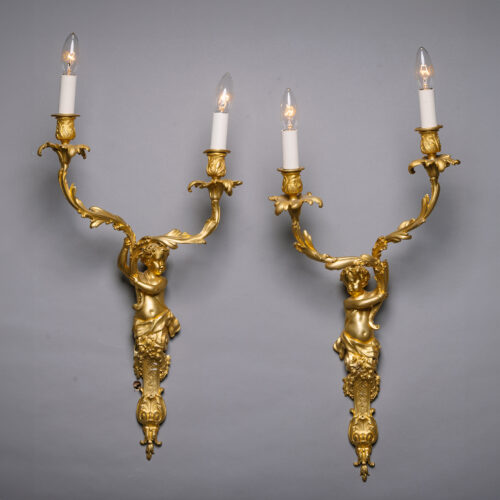保罗-索马尼
An Important Louis XVI Style Marquetry Inlaid Marble-Top Commode
£68,000
An Important Louis XVI Style Marquetry Inlaid Marble-Top Commode by Paul Sormani. Stamped twice beneath the marble top 'SORMANI Paris'. The lockplate...
尺寸
Height: 86 cm (34 in)Width: 130 cm (52 in)
Depth: 60 cm (24 in)
描述
An Important Louis XVI Style Marquetry Inlaid Marble-Top Commode by Paul Sormani.
Stamped twice beneath the marble top ‘SORMANI Paris’.
The lockplate engraved ‘P. Sormani Paris 10 R. Charlot’.
This impressive and unusual commode has a demi-lune shaped brêche violette marble top above an inlaid frieze drawer over two long drawers, flanked by finely inlaid cabinet doors with marquetry panels depicting figures in classical scenes.
法国,约1870年。
The fashion for marquetry depicting classical ruins is indebted to the context of discovery and excavations in the mid-18th century of major sites such as Herculaneum and the Villa of the Papyri. This semi-circular form of the commode and the profusion of its marquetry decoration relate directly to commodes made in the 1780s by Charles Topino and André-Louis Gilbert. As becoming of a replicator par excellence, the profusion of marquetry makes this example by Paul Sormani more than the equal of such forebearers. The neoclassical ornament is supplemented to the side doors by marquetry roundels of arcadian figures. The left door with a figure of a boy out hunting is complimented by a figure of a female musician to the right side door. The two depicted as if in conversation, tell their own story of courtship.
日期
约1870年
原产地
法国
中型
镶嵌和镀金铜
签名
Stamped twice beneath the marble top 'SORMANI Paris'. The lockplate engraved 'P. Sormani Paris 10 R. Charlot.'
Born in Venice in 1817, Paul Sormani (1817-1877), was a Parisian maker of fine ‘meubles de luxe’. His work was described in the catalogue of the 1867 Exposition Universelle as: ‘toute sa production révèle une qualité d’exécution de tout premier ordre’ (all of his production reveals a quality of execution all of the first order’).
Sormani exhibited at the International Exhibitions in Paris in 1849, 1855, 1867, 1878 and 1900, and in London in 1862, winning numerous medals.
Paul Sormani established the firm in 1847 at 7 Cimetière Saint-Nicolas in Paris, moving in 1854 to 114 rue du Temple, and in 1867 to 10 rue Charlot.
After his death in 1877 Sormani’s son Paul-Charles took over the business that later moved to 134 Boulevard Haussmann.
It can be difficult to date Sormani’s work, as the firm produced furniture for nearly ninety years. However, when Paul Sormani died in 1877, his wife and son took over the business and from this date onwards pieces are normally signed ‘Veuve Sormani & Fils’.
Bibliography:
Mestdagh, Camille & Lécoules, Pierre. L’Ameublement d’art français : 1850-1900, Les Editions de l’Amateur, (Paris), 2010.
Meyer, Jonathan. Great Exhibitions – London, New York, Paris, Philadelphia, 1851-1900, Antique Collectors’ Club, (Woodbridge, UK), 2006.
Ledoux – Lebard, Denise. Les Ébénistes du XIXe siècle, Les Editions de L’Amateur, (Paris), 1984; pp. 583-588.



















 印刷品
印刷品


